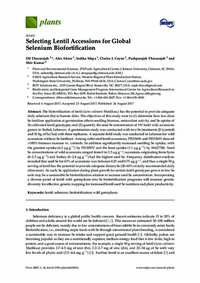Selecting Lentil Accessions for Global Selenium Biofortification

Authors:
The biofortification of lentil (Lens culinaris Medikus.) has the potential to provide adequate daily selenium (Se) to human diets. The objectives of this study were to (1) determine how low-dose Se fertilizer application at germination affects seedling biomass, antioxidant activity, and Se uptake of 26 cultivated lentil genotypes; and (2) quantify the seed Se concentration of 191 lentil wild accessions grown in Terbol, Lebanon. A germination study was conducted with two Se treatments [0 (control) and 30 kg of Se/ha] with three replicates. A separate field study was conducted in Lebanon for wild accessions without Se fertilizer. Among cultivated lentil accessions, PI533690 and PI533693 showed >100% biomass increase vs. controls. Se addition significantly increased seedling Se uptake, with the greatest uptake (6.2 µg g−1) by PI320937 and the least uptake (1.1 µg g−1) by W627780. Seed Se concentrations of wild accessions ranged from 0 to 2.5 µg g−1; accessions originating from Syria (0–2.5 µg g−1) and Turkey (0–2.4 µg g−1) had the highest seed Se. Frequency distribution analysis revealed that seed Se for 63% of accessions was between 0.25 and 0.75 µg g−1, and thus a single 50 g serving of lentil has the potential to provide adequate dietary Se (20–60% of daily recommended daily allowance). As such, Se application during plant growth for certain lentil genotypes grown in low Se soils may be a sustainable Se biofortification solution to increase seed Se concentration. Incorporating a diverse panel of lentil wild germplasm into Se biofortification programs will increase genetic diversity for effective genetic mapping for increased lentil seed Se nutrition and plant productivity.
